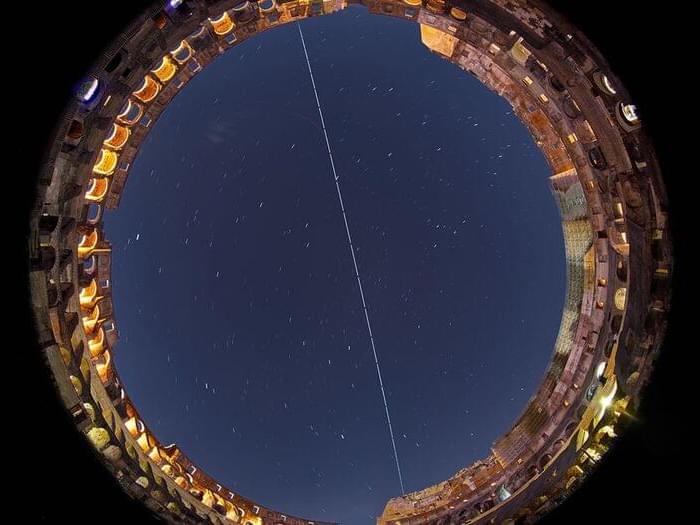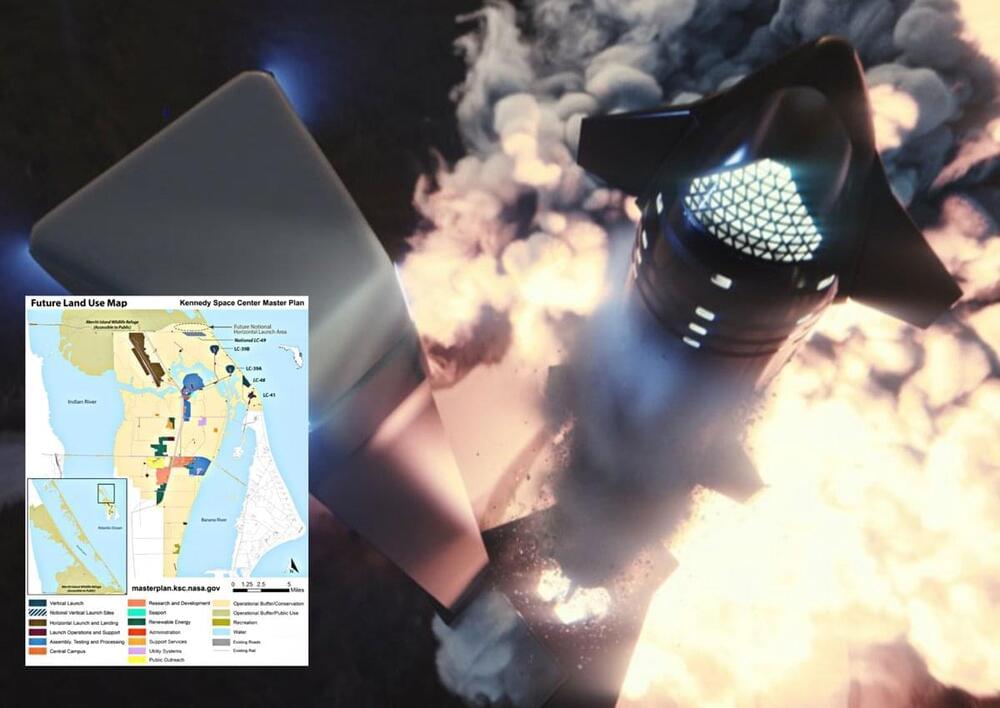Billionaire Tesla and SpaceX CEO Elon Musk shared a video on Twitter of the giant Starship and its steering engines, a sign production may be back on track.



Jeff Bezos’ Blue Origin has announced an ambitious plan to operate its own commercial space station called Orbital Reef sometime after 2024.
“Designed to open multiple new markets in space, Orbital Reef will provide anyone with the opportunity to establish their own address on orbit,” the company announced on Monday. Blue Origin describes the station as a “mixed used business park” in space. Orbital Reef will reside in a low Earth orbit at 310 miles, and function as a hub for research, commerce, tourism and logistics, where spaceships can also come and go.
Jeff Bezos’s company is partnering with Sierra Space and Boeing to build the space station, which is meant to be an orbiting business park.

“Looking at the starry sky, with those thousand-year-old walls embracing the ancient constellations and the passing, modern ISS, was undoubtedly a once-in-a-lifetime experience,” Masi said in a statement on Thursday.
Masi also released an annotated version of the image showing constellations marked and labeled, from Pegasus to Ursa Minor.
The Colosseum is nearly 2,000 years old. The ISS has been in space for over 20 years. They are very different kinds of monuments, but they meld together beautifully in an image that speaks to the past and the present and how far humans have traveled.

“Specialists of the Central Military District’s search/rescue and parachute service have been relocated in full to the Republic of Kazakhstan to provide for the safe landing of the Soyuz MS-20 descent capsule with space tourists from Japan on its board,” the press office said in a statement.
The Central Military District has redeployed additional personnel from the Chelyabinsk Region in the Urals to bolster the basic group that provided for the safe launch of the Soyuz spacecraft. In particular, about 50 more rescuers have been redeployed to Kazakhstan together with eight Mi-8 helicopters and two PEM-1 and PEM-2 ‘Blue Bird’ search and evacuation vehicles, the statement says.
Overall, the search and rescue operation to provide for the safe landing of the Soyuz MS-20 descent module involves about 200 rescuers, 12 Mi-8 helicopters, two An-12 planes and an An-26 aircraft and over 20 motor vehicles, including six pieces of ‘Blue Bird’ rescue and evacuation equipment.

The prospect of Starship making its mark on the Space Coast entered another level this week when NASA revealed it would conduct environmental assessments on LC-49 to support Starship launch and landing operations.
With SpaceX already confirming they will restart work on a Starship pad inside 39A, the potential of a second site at LC-49 could provide a considerable increase in Starship launch cadence from the Kennedy Space Center (KSC).

Bill Gates’ multibillion-dollar clean-tech initiative Breakthrough Energy Ventures has completed a $65 million funding round for the reusable rocket developer called Stoke Space, according to a Wednesday press release.
So don’t look away, because you might miss the makings of humanity’s future.

On December 15, NASA announced that SpaceX submitted a new proposal to build a Starship launch site at Launch Complex-49 in Cape Canaveral, Florida. Previously, SpaceX officials mentioned plans to build a Starship launch tower at historic Launch Complex-39A, the launch site from where NASA Apollo astronauts lifted off atop Saturn V on a voyage to the Moon half a century ago. NASA and SpaceX are working to return humans to the lunar surface by 2025. SpaceX is developing a lunar-optimized Starship Human Landing System (HLS) to land astronauts on the moon as part of the Artemis program that aims to build a sustainable presence on our closest celestial neighbor.
The unbuilt Launch Complex-49 is an 175-acre land located north of Launch Pad-39B and Pad-39A at NASA’s Kennedy Space Center premises. The agency released a map of the region, pictured below, that outlines the locations of each launch site. “LC-49 has been a part of Kennedy’s master plan for several years,” said Tom Engler, Kennedy’s director of Center Planning and Development. “The Notice of Availability was updated in 2014.”
“Every new construction project, whether government or commercial, goes through a comprehensive environmental review process,” said Don Dankert, technical lead for the Kennedy Environmental Planning Office. “This ensures that we are able to identify potential environmental impacts and define any associated mitigations prior to project implementation.”

The 24thSpaceX cargo resupply services mission, targeted to launch in late December from NASA’s Kennedy Space Center in Florida, carries scientific research and technology demonstrations to the International Space Station. The experiments aboard include studies of bioprinting, crystallization of monoclonal antibodies, changes in immune function, plant gene expression changes, laundering clothes in space, processing alloys, and student citizen science projects.

Less than two weeks after CEO Elon Musk revealed that SpaceX has restarted construction of a Starship launch site at Kennedy Space Center’s existing LC-39A pad, NASA has revealed the company’s plans for an entirely different Starship launch site just a few miles to the north.
Known as Launch Complex 49 (LC-49) and located where NASA once considered building LC-39C, a third Saturn-class pad to match 39A and 39B, NASA now says that SpaceX aims to develop the site into a dedicated Starship launch pad. The plot of land NASA deemed LC-49 as recently as 2017 sits about 1 mile (1.6 km) northwest of NASA’s LC-39B Space Launch System (SLS) pad and 3 miles (5 km) northwest of LC-39A, which SpaceX has leased since 2014 and launched out of since 2017. Unlike 39A, though, SpaceX has a huge amount of work – and major environmental reviews – ahead of it to turn LC-49 into a site capable of launching a rocket more than twice as powerful as Saturn V.
As of today, “LC-49” amounts to a mostly arbitrary dotted line on a map. Situated a few thousand feet south of the lovingly named Mosquito Lagoon Aquatic Preserve and Canaveral Seashore National Park, the site encompasses a variety of wild wetlands and is fully undeveloped. While substantially wetter, the land SpaceX hopes to develop is actually quite similar to the site that now hosts Starbase’s Starship launch facilities in Boca Chica, Texas. Prior to SpaceX’s arrival, the area was empty coastal mudflats.

Start listening with a 30-day Audible trial and your first audiobook plus two Audible Originals are free. Visit.
http://www.audible.com/isaac or text “ISAAC” to 500-500.
Interstellar travel is very time consuming, moving from star to star, but perhaps we could use stars themselves as spaceships, and move whole solar systems or even galaxies.
Today we’ll look at how to use Shkadov Thrusters, novas, supernovae, black holes and quasars to move through space, literal starships.
Visit our Website: http://www.isaacarthur.net.
Support us on Patreon: https://www.patreon.com/IsaacArthur.
SFIA Merchandise available: https://www.signil.com/sfia/
Social Media:
Facebook Group: https://www.facebook.com/groups/1583992725237264/
Reddit: https://www.reddit.com/r/IsaacArthur/
Twitter: https://twitter.com/Isaac_A_Arthur on Twitter and RT our future content.
SFIA Discord Server: https://discord.gg/53GAShE
Listen or Download the audio of this episode from Soundcloud: Episode’s Audio-only version: https://soundcloud.com/isaac-arthur-148927746/fleet-of-stars.
Episode’s Narration-only version: https://soundcloud.com/isaac-arthur-148927746/fleet-of-stars-narration-only.
Credits:
Generation Ships: Fleet of Stars.
Episode 186, Season 5 E20
Written by:
Isaac Arthur.